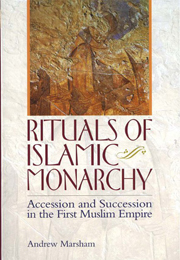Book contents
- Frontmatter
- Contents
- List of maps and figures
- Acknowledgements
- Map 1
- Map 2
- Map 3
- INTRODUCTION
- PART I LATE ANTIQUE ARABIA AND EARLY ISLAM (c. 550–c. 660)
- PART II THE UMAYYAD CALIPHATE (c. 660–750)
- INTRODUCTION
- 4 SUFYANID ACCESSION AND SUCCESSION, c. 660–683
- 5 THE OATH OF ALLEGIANCE IN THE EARLY TRADITION AND POETRY, c. 680–c. 710
- 6 THE MARWANID PATRIMONY AND DYNASTIC SUCCESSION
- 7 MARWANID RITUALS OF ACCESSION AND SUCCESSION
- 8 WRITING AND THE BAYcA IN THE MARWANID PERIOD
- 9 THE QURANIC CONTENT OF THE MARWANID DOCUMENTS
- PART III THE EARLY ABBASID CALIPHATE (c. 750–809)
- PART IV THE MIDDLE ABBASID CALIPHATE (809–865)
- CONCLUSION
- Genealogical table of Quraysh
- Genealogical table of the Abbasid caliphs
- Bibliography
- Index
4 - SUFYANID ACCESSION AND SUCCESSION, c. 660–683
from PART II - THE UMAYYAD CALIPHATE (c. 660–750)
Published online by Cambridge University Press: 05 September 2013
- Frontmatter
- Contents
- List of maps and figures
- Acknowledgements
- Map 1
- Map 2
- Map 3
- INTRODUCTION
- PART I LATE ANTIQUE ARABIA AND EARLY ISLAM (c. 550–c. 660)
- PART II THE UMAYYAD CALIPHATE (c. 660–750)
- INTRODUCTION
- 4 SUFYANID ACCESSION AND SUCCESSION, c. 660–683
- 5 THE OATH OF ALLEGIANCE IN THE EARLY TRADITION AND POETRY, c. 680–c. 710
- 6 THE MARWANID PATRIMONY AND DYNASTIC SUCCESSION
- 7 MARWANID RITUALS OF ACCESSION AND SUCCESSION
- 8 WRITING AND THE BAYcA IN THE MARWANID PERIOD
- 9 THE QURANIC CONTENT OF THE MARWANID DOCUMENTS
- PART III THE EARLY ABBASID CALIPHATE (c. 750–809)
- PART IV THE MIDDLE ABBASID CALIPHATE (809–865)
- CONCLUSION
- Genealogical table of Quraysh
- Genealogical table of the Abbasid caliphs
- Bibliography
- Index
Summary
Only with the victory of the Marwanid Umayyads in the second civil war (683–92) does evidence for caliphal accession and sucession become plentiful. However, what evidence there is for the Sufyanid Umayyad period indicates that many aspects of Marwanid ritual had precedents in late-seventh-century practice. Indeed, with hindsight, the reign of Mucāwiya b. Abī Sufyān (r. 661–80) and that of Yazīd, his son (r. 680–3), can be seen as a period of experimentation with the trappings of Near Eastern monarchy, and the prelude to the establishment of a more successful Islamic state by their Marwanid cousins after the second fitna of 683–92. This is evident both in an account of the rituals of Mucāwiya's accession, which an early Syriac source records in some detail, and in the efforts to establish Yazīd b. Mucāwiya as Mucāwiya's successor. In what follows, the Syriac acccount of Mucāwiya's accession is analysed, before a discussion of the efforts to secure the succession of Yazīd.
THE ACCESSION OF MUcĀWIYA B. ABĪ SUFYĀN
The accession of Mucāwiya as caliph at the end of the first civil war in c. 660 is unique among Umayyad accession rituals for being recorded in a near-contemporaneous source. The ‘Maronite Chronicle’ in which it is described was compiled between 664 and 727 – most likely in the seventeen years between 664 and 681 – by an anonymous Maronite Christian author living in Syria.
- Type
- Chapter
- Information
- Rituals of Islamic MonarchyAccession and Succession in the First Muslim Empire, pp. 86 - 95Publisher: Edinburgh University PressPrint publication year: 2009



